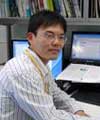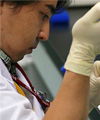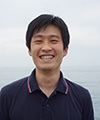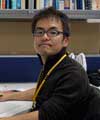Outline
Deep drilling of marine subsurface offers unique opportunities to explore how microbial life persists and evolves in the Earth's interior ecosystems. There are very few natural environments on the Earth's surface biosphere where life is absent; however, the limits to life are expected in the deep subseafloor biosphere. Activity of subseafloor sedimentary microbes plays significant ecological roles in biogeochemical carbon cycles over geologic time, such as the formation of unconventional biogenic hydrocarbon reservoirs. However, the extent and limits of the deep subseafloor biosphere on the Pacific margins and factors constrain life at its lower boundaries remain largely unknown.
Since the first deep biosphere-dedicated Ocean Drilling Program (ODP) Leg 201 using the US drill ship JOIDES Resolution in 2002, scientific ocean drilling has offered unique opportunities to expand our knowledge of the nature and extent of the deep biosphere. The latest estimate of the global subseafloor microbial biomass is ~1029 cells, accounting for 4 Gt of carbon and ~1% of the Earth's total living biomass. The subseafloor microbial communities are evolutionarily diverse and their metabolic rates are extraordinarily slow. Nevertheless, accumulating activity most likely plays a significant role in elemental cycles over geological time.
In 2010, during Integrated Ocean Drilling Program (IODP) Expedition 329, the JOIDES Resolution explored the deep biosphere in the open-ocean South Pacific Gyre—the largest oligotrophic province on our planet. During Expedition 329, relatively high concentrations of dissolved oxygen and significantly low biomass of microbial populations were observed in the entire sediment column, indicating that (i) there is no limit to life in open-ocean sediment and (ii) a significant amount of oxygen reaches through the sediment to the upper oceanic crust. This "deep aerobic biosphere" inhabits the sediment throughout up to ~37 percent of the world's oceans. The remaining ~63 percent of the oceans is comprised of higher productivity areas that contain the "deep anaerobic biosphere".
In 2012, during IODP Expedition 337, the Japanese drill ship Chikyu explored coal-bearing sediments down to 2,466 meters below the seafloor off the Shimokita Peninsula, Japan. Geochemical and microbiological analyses consistently showed the occurrence of methane-producing communities associated with the coal beds. Cell concentrations in deep sediments were notably lower than those expected from the global regression line, implying that the bottom of the deep biosphere is approached in these beds. Taxonomic composition of the deep coal-bed communities profoundly differs from those in shallower marine sediments and instead resembles organotrophic communities in forest soils. These findings suggest that the terrigenous microbial ecosystem has been partly retained from the original depositional setting over 20 million years and contributed to deep carbon cycling ever since.
What are the factors that limit microbial biomass, diversity, activity and evolution in the deep subseafloor biosphere? To address this important question, in 2015, we will conduct the Chikyu's International Ocean Discovery Program (IODP) Expedition 370 "T-Limit of the Deep Biosphere off Muroto" and drill through ~1.2 km-deep sediments down to the basaltic basement at the toe of plate subduction zone in the Nankai Trough off Cape Muroto, Kochi Prefecture, Japan. Anomalously high heat flow regimes were observed in this area, resulting in temperatures of ~130°C at the sediment-basement interface, and therefore will most likely across the current temperature limit of cultivable microbial life at around 120°C and the biotic-abiotic transition zone in the sedimentary environment. Using the state-of-the-art microbiological and geochemical techniques, the IODP T-Limit project aims (1) to study the factors that control biomass, activity and diversity of microbial communities in a subseafloor environment where temperatures increase from ~30°C to 130°C and thus likely encompasses the biotic-abiotic transition zone, and (2) to determine geochemical, geophysical and hydrogeological characteristics in sediments and the underlying basaltic basement and elucidate if the supply of fluids containing thermogenic and/or geogenic nutrient and energy substrates may support subseafloor microbial communities in the Nankai accretionary complex.
Scientific Objectives
- To understand the extent and limits of subseafloor life and the deep biosphere
- To clarify biogeochemical consequences of carbon and other elemental cycles in the deep subseafloor biosphere
- To decipher the origins and evolutionary processes of subseafloor microbial life
- To develop new technologies to reveal unseen life signatures in geologic samples
Members

Go-ichiro Uramoto Guest Researcher





